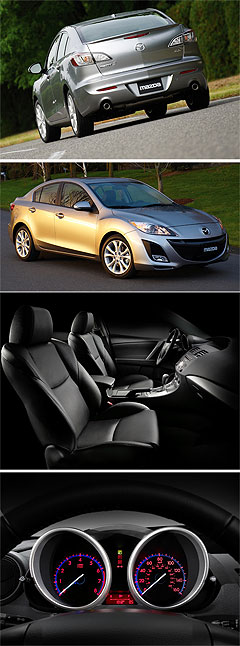Future models - Mazda - Mazda3 - SedanFirst drive: Mazda improves its Three breedBroad appeal: Mazda's new small car is likely to attract young and old alike. The new Mazda3 is better in almost every respect than its top-selling forebear24 Nov 2008 THE new Mazda3 does not drive as differently to the current model as its radical new sheetmetal suggests, but one could easily mount the argument that it doesn’t need to. A range of technical changes to the already-sharp global Ford small-car family platform makes the new Three’s chassis feel even tauter, as well as more refined and quieter, addressing the biggest single criticism levelled at its predecessor. The second-generation Mazda3’s steering is also a little sharper and it corners flatter and with more poise and precision than before, seemingly without any loss of ride comfort – at least on the smooth but undulating surfaces we experienced during the global launch of the sedan in the spectacularly twisting mountain roads west of Los Angeles. Of course, the new Mazda3 comes off a high base and replaces a model that accounts for almost a third of the resurgent Japanese maker’s worldwide sales and an even greater proportion in Australia, where more than 150,000 sales have made it the nation’s most popular vehicle among private purchasers. So it comes as no surprise that the new model, even though it employs an “evolution” of the C1 chassis architecture that also underpins models like the Ford Focus and Volvo C30/S40/V50, easily cements its position as the most accomplished Japanese car in the small-car class when it comes to ride and handling.  Okay, so there’s a minor ‘dead spot’ as you wind on the steering lock, be it from the straight-ahead or while already turning, that stops the redesigned Three from matching the precision of Ford’s European-built Focus, let alone BMW’s class-leading rear-drive 1 Series hatch, which is at least $20,000 more expensive. Okay, so there’s a minor ‘dead spot’ as you wind on the steering lock, be it from the straight-ahead or while already turning, that stops the redesigned Three from matching the precision of Ford’s European-built Focus, let alone BMW’s class-leading rear-drive 1 Series hatch, which is at least $20,000 more expensive.And the carryover 2.0-litre four-cylinder engine, while vastly better-isolated from the cabin than before, remains the loudest part of the Mazda3 driving experience at all times. Borrowed from the new Mazda6, the 2.3-replacing 2.5-litre four that will power our SP25 hatch and sedan is louder still, even if it offers stronger performance right across the rev range, which falls 500rpm short of the 2.0-litre at nearly 6500rpm. While the interior is as stylish and appealing as the cool new exterior, we think the superb soft-look-and-touch dashboard material could have extended to contact areas of the 2.0-litre cars like the centre and door armrests, as it does on the 2.5s. The carryover braking systems of both models we drove also suffered serious brake fade problems during super-enthusiastic driving on a number of downhill sections. That in itself was not altogether surprising, but the speed at which braking performance fell away did. Fortunately, once allowed to cool, their performance improved as quickly as it dissipated. While the two 2.5-litre cars we drove handled more crisply than the outgoing Mazda3 and delivered a notably more accomplished ability to change direction with European-style fluidity and composure, one was inexplicably slightly softer than the other. This was despite Mazda’s insistence that the US and Canadian-spec pre-production vehicles at the launch would carry the same suspension tune as European and Australian models. Curiously, both 2.5s also presented a touch of steering kickback over the same road lumps that didn’t upset the 2.0-litre car we drove, and their more heavily-bolstered, leather-clad front seats (which will be standard in our SP25s) offered far better lateral support than the flatter cloth-trimmed seats found in 2.0-litre models. Rear leg and head room is adequate rather than generous (though the latter should again be better in the hatch) and there is no centre rear head restraint. But that’s where our criticisms of the new Mazda3 end. We love the bold and cheeky new skin that features a complex arrangement of cleverly resolved character lines and body jewellery, and think it will be a hit with both young and not-so-young small-car buyers alike – even if it cloaks a platform that is fundamentally five years old. The new interior is equally fresh, vibrant and significantly raises the bar for Mazda’s C-segment model via the use of higher-quality materials, a one-piece lower console/dashboard and a classier but still highly ergonomic overall layout that comprises a driver-oriented cockpit with heavily recessed twin instrument binnacles, a dash-top multi-information display and a multifunction steering featuring audio, trip and navigation controls. Mated to a carryover six-speed manual transmission as standard or an optional new five-speed automatic gearbox to replace the outgoing four-speeder, putting the Mazda3 at the pointy end of the class in terms of transmission technology, the Three’s 2.0-litre engine was already among the leaders in its field with 108kW and 182Nm of torque. So it seems Mazda has done enough in the areas that really matter to small-car buyers to keep its volume-selling model at the pointy end of its field. Tauter, sharper, quieter, better-equipped and dressed even better both inside and out than before, the new Mazda3 should easily continue its forebear’s tradition of being one of Australia’s top-selling small cars. Read more:Mazda3 to be fast-tracked for OzLA show: Mazda's three-box debut Sydney show: Mazda3 makes global debut Rotary won’t die but current Mazda3 a hard act to follow New Mazda3 stands aside Mazda3 pricing
Motor industry news |
Click to shareMazda modelsResearch Mazda Mazda3 pricing
Motor industry news |














Facebook Twitter Instagram